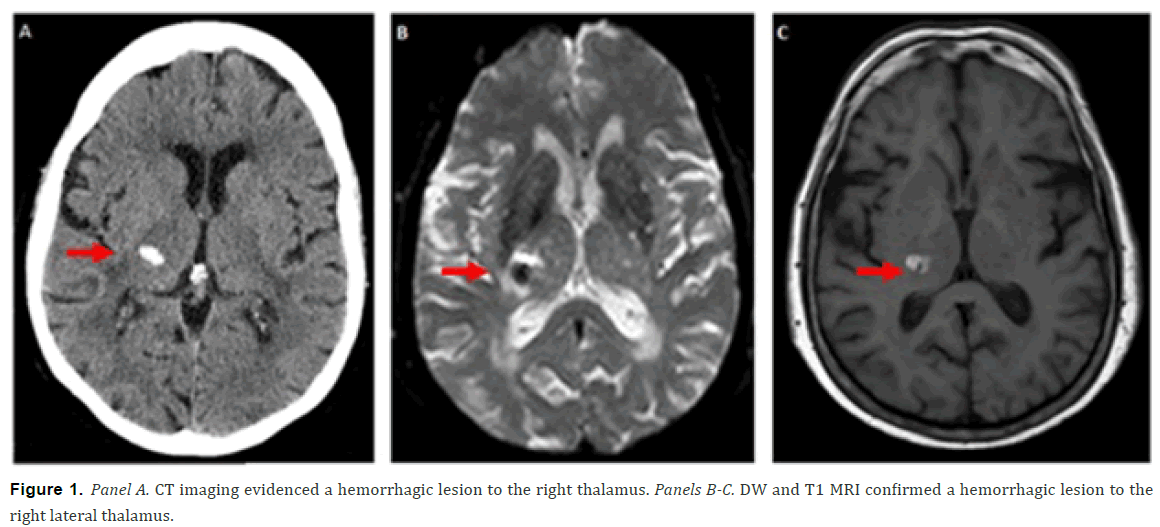Clinical images Open Access
Thalamic Hemiataxia
Domizia Vecchio, Claudia Varrasi, Gionata Strigaro*, Roberto CantelloDepartment of Translational Medicine, Section of Neurology, University of Piemonte Orientale “A. Avogadro”, Novara, Italy
Visit for more related articles at International Journal of Emergency Mental Health and Human Resilience
Description
A 75-year-old woman presented with acute onset of unbalance and impaired coordination in her left limbs with normal sensations. Neurologic examination showed dysmetria at her left extremities, mild dysdiadochokinesia to her left hand with apparent intact vibration and position senses. Her gait was wide-based and ataxic, and Romberg sign was negative, but she had a tendency to fall to the left side (Supporting information, video). Brain computerized tomography (CT) evidenced a small hemorrhagic lesion to the right thalamus (Figure 1, Panel A), localized at the right lateral thalamus by the diffusion-weighted (DW) and T1 Magnetic Resonance Imaging (MRI) (Figure 1, Panels B-C). Somatosensory evoked potentials showed reduced amplitude of the right N20. Transcranial magnetic stimulation revealed a defective cerebellar -brain inhibition over the right motor cortex suggesting an impairment of the cerebellothalamo- cortical pathway (Kikuchi, Mochizuki, Moriya et al., 2012). Cerebellar hemiataxia is rarely caused by a lesion in the controlateral thalamus affecting the cerebellar-thalamo-cortical pathway (Perren et al., 2005; Schmahmann, 2003).
Supporting Information
Video. Thalamic hemiataxia. Neurologic examination showed dysmetria at the left extremities, mild dysdiadochokinesia to the left hand, wide-based and ataxic gait with a tendency to fall to the left side.
References
- Kikuchi, S., Mochizuki, H., Moriya, A., et al. (2012). Ataxic hemiparesis: neurophysiological analysis by cerebellar transcranial magnetic stimulation. Cerebellum, 11, 259-63.
- Perren, F., Clarke, S., &Bogousslavsky, J. (2005). The syndrome of combined polar and paramedian thalamic infarction. Archives of neurology, 62(8), 1212-6.
- Schmahmann, J. D. (2003). Vascular syndromes of the thalamus. Stroke, 34(9), 2264-78.
Relevant Topics
Recommended Journals
Article Tools
Article Usage
- Total views: 15232
- [From(publication date):
March-2015 - Apr 06, 2025] - Breakdown by view type
- HTML page views : 10632
- PDF downloads : 4600

